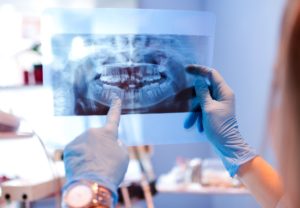Header logo
header top contact widget
Aesthetic Gum Treatment
Using A Manual Or Electric Toothbrush Could Make A BIG Difference.
Posted on Sep 11, 2019 by William J. Claiborne, DDS MS
If you use an electric toothbrush, that can help in the prevention of tooth loss. However, it’s but one part of the steps needed for thorough oral hygiene at home.
Findings of an 11 year study published in the Journal of Clinical Periodontology tracked the oral health of over 2800 adults. Their use of electric toothbrushes was monitored to watch for periodontal disease, cavities, and the number of natural teeth.
Participants were examined in 2002 – 2006, with 18 percent being electric tooth brush users. Follow ups were conducted after six and 11 years. At the time of their 11 year follow up, 37 had converted to using electric toothbrushes.
The study showed electric brushing promoted better gum health and slower progression of gum disease. Electric tooth brushing also related to a reduction in tooth loss by 20 percent (compared to those who brush with manual toothbrushes). The study did not reveal measurable reduction in cavities, however.
Although more adults are using them, their long-term effectiveness has not been proven to be significant. It is suspected that this is due to technique more than the brushing tool itself. For manual brushers, a major hazard with manual brushes is one’s choice of bristles. Stiffer bristles can be very damaging.
If you use a hard bristle tooth brush, you may be damaging tooth enamel and gum tissues. People often feel they need to press down firmly as they brush and use a scrubbing, ‘back & forth’ motion. This action can wear down the protective shell of tooth enamel, leaving teeth more vulnerable to decay.
Another problem with using a hard bristle tooth brush is its ability to damage tender gum tissues. If the bristles on your toothbrush are fanned out after a couple of months, it’s because you are applying too much pressure when brushing.
The ideal technique for brushing teeth is applying gentle pressure on the brush in a swirling motion. By using a circular pattern over both sides of each tooth and along the tops, teeth are cleansed without wearing away gum tissues.
This is where electric toothbrushes can help greatly. Many of the newer models include timers to indicate the time needed for each quadrant of your mouth. This is your teeth divided into 4 sections. They also warn you when you are using too much pressure.
While tooth enamel is important, equally so are the health of your gum tissues. The gums provide a seal around the base of each tooth. This seal helps to prevent the entry of bacteria that can lead to periodontal (gum) disease, which the nation’s leading cause of adult tooth loss.
As devastating as tooth loss can be to one’s overall health, as we now know that the bacteria of gum disease can enter the bloodstream. Research has shown this infectious bacteria can trigger inflammatory reactions elsewhere in the body, correlating to heart disease, stroke, high blood pressure, some cancers, diabetes, arthritis, impotency, preterm babies and more.
Whether using a manual or electric tooth brush, it is necessary to brush twice a day for effective results. In order to thoroughly remove the sticky film of plaque from teeth, you should also brush at least two minutes each time.
Plaque is a buildup of oral bacteria that coats teeth and gums. If not removed daily, it forms a hardened mass of calculus (or tartar) that attaches to teeth. This is what you may feel your hygienist scraping off teeth during cleanings since it cannot be brushed or flossed away.
Another place for oral bacteria to thrive are the grooves in the tongue. These offer a dark, warm and moist environment for bacterial reproduction. To uproot these organisms (that reproduce rapidly), use your toothbrush to brush your tongue after brushing teeth. Be sure to reach the back of the tongue where the majority of oral bacteria are embedded. Swish with water several times after.
Another way to improve gum health, lower cavity risk, and prevent tooth loss is through flossing. It is estimated that only 31 percent of American adults floss on a daily basis. Because brushing cannot dislodge all food particles caught between teeth, daily flossing should be a part of oral hygiene routines.
Flossing removes trapped bits of food remain in the mouth, which feeds oral bacteria and helps them to quickly multiply. Proper flossing is easy for those who are in the habit of it and takes under a minute each day. For those who have problems with manual dexterity or find the maneuver awkward, water flossers are effective alternatives and easy to use.
Practice the recommended techniques mentioned above and you’ll not only do a better job at having a clean mouth, you’ll find your time at the sink requires less effort. If you feel you may be experiencing symptoms of periodontal disease, however, don’t delay. You should be seen at your earliest convenience for treatment since this disease will only worsen over time.
Signs of gum disease include tender gums that bleed easily when brushing, gums that darken in color to red (versus a healthy pink), frequent bad breath, and gums that pull away from teeth (receded gums) and expose darker root areas of the tooth.
If you’ve noticed any of these, please know that the condition will only worsen without treatment. As a periodontist, I specialize in gum tissues (as well as dental implants). Our environment optimizes patient outcomes and comfort throughout treatment.
Call 828-274-9440 to learn more.
React To Gum Disease EARLY To Save Time & Money On Treatment.
Posted on Aug 08, 2019 by William J. Claiborne, DDS MS
“Hindsight is 20-20.”
This saying describes how, if we’d “known then what we know now…” we may have taken a different course of action for a better outcome.
In cases where gum disease develops or tooth loss occurs, patients often wish they could turn back the hands of time. Many patients who have acquired gum disease or had teeth replaced because of it are now highly-committed to their oral health. They often tell us, “I wish I’d taken better care of my mouth before,” now realizing how problems can be avoided as well as the benefits of good oral health.
Periodontal (gum) disease and (often) its subsequent tooth loss are, simply put, products of bacterial overload in the mouth. Our mouths are constantly being supplied with sustenance for these organisms. Bacteria are able to thrive through food that enters, especially sugars, and other bacteria-laden items put into the mouth. As bacteria thrive, they are able to reproduce very rapidly.
When bacteria levels become more than the immune system can tackle, infection can set in. Just as a cut or scrape on the skin that is not kept sufficiently clean can become infected, oral bacteria can cause an infection to develop in the mouth. This accumulation of bacteria can evolve into gum disease, which is an inflammation that attacks teeth, oral tissues and the bone structures that support tooth roots.
Gum disease symptoms include sore gums that bleed when brushing, frequent bad breath, gums that pull away from the base around teeth, gums that darken in color. As it worsens, pus pockets may form on the gums at the base of some teeth. In advanced stages, gum disease causes teeth to loosen and eventually require removal.
Gum disease often progresses because people are unaware that bleeding or receding gums is actually a symptom. Insufficient brushing, failing to floss and not having regular dental cleanings form a path that begin the process.
Insufficient care can lead to a build-up of bacteria, known as plaque. Plaque is a sticky (or “fuzzy”) film you feel on teeth when not removed on a regular basis. In just 48 hours, plaque can transform into a cement-hard colony of oral bacteria that attaches to teeth. This hardened form of bacteria is known as tartar or calculus. Unlike plaque, tartar cannot be brushed or flossed away.
As your mouth is enduring the repercussions of oral bacteria accumulation, gum tissues and tooth enamel are attacked. Once this infectious bacteria has penetrated below the gum line, dental treatment is necessary to halt its continued development and restore healthy gums
With prompt and proper measures, however, you can halt and reverse the need for dental treatment and avoid the repercussions of gum disease.
Gingivitis is the initial stage of gum disease. Symptoms typically include gums that are tender in spots and some bleeding when you brush. These are warning signs that signal an immediate need for attention.
Begin by twice daily brushing with a soft bristle tooth brush and use a fluoridated tooth paste. Brush for at least two minutes each time. Floss daily. Be sure not to pop the floss between teeth to avoid damaging tender gums. Move the floss in a back-&-forth motion between teeth to ease it down so you can scrape the sides of each tooth.
You can remove a tremendous amount of oral bacteria by using a tongue scrapper daily. Or, brush your tongue with your tooth brush at the end of each brushing. This helps to dislodge bacteria that is embedded in the grooves of the tongue.
Drink lots of water during the day. This will help keep saliva flow at ample levels. Saliva is designed to move oral bacteria from the mouth on a consistent basis. Oral dryness is the enemy. Avoid foods and beverages that are drying to oral tissues such as caffeine, alcohol, and spicy foods. Also, try to minimize the amount of sugar and carbohydrates you consume. These foods amplify the reproduction of oral bacteria.
If you smoke, consider using an oral rinse that replenishes moisture in the mouth. The chemicals in cigarette smoke are verey drying to oral tissues. Some oral rinses are specifically designed for producing moisture. Remember, oral dryness gives bacteria a favorable environment for reproduction.
When it comes to the initial formation of gingivitis, these steps will help relieve gum tenderness and potential to bleed within a week or so. If you do not see improvement after 2 weeks of diligent measures, see a periodontal specialist as soon as possible.
A periodontist is a dental specialist who can determine your precise level of gum disease and the most appropriate treatment to restore good oral health.
Call 828-274-9440 if you have questions about your gums or if you are experiencing any symptoms associated with gum disease.
A Dry Mouth Can Have Many Causes And Lead To A Number Of Oral Health Problems
Posted on Jun 21, 2019 by William J. Claiborne, DDS MS
Our lips and teeth – our smile – is a stage curtain to what is actually going on inside the mouth. As an Asheville periodontist, I have a daily view of the hazards that exist beyond the veil.
Oral bacteria is the root source of most problems that occur in the mouth. Their presence is normal, of course. The mouth (or “oral cavity”) is designed to be able to manage a certain level of oral bacteria. It is the over-accumulation of this bacteria that is the origination source of many problems.
Although certain foods, such as a garlicky shrimp or onion-laden hot dogs, can create “stand-offish” bad breath, this breath odor is temporary. The bad breath that is truly offensive and occurs on a more consistent basis comes from an overload of oral bacteria.
The reason we’re advised to brush at least twice a day and floss our teeth daily is to remove accumulated oral bacteria from the mouth. When not removed on a regular basis, the bacteria form a sticky film that coats the teeth and gums. This film is known as plaque.
Keep in mind that bacteria are living, eating, and reproducing organisms. Because they eat, they also create waste – in our mouths! Although that in itself should be reason enough to be committed to brushing and flossing, without pain, people assume that all is well.
Yet, an over-accumulation of oral bacteria can lead to far worse than bad breath. Because oral bacteria critters eat, they look to the gum tissues. As they amass, they can create an inflammation that extends beneath the gum line. The infection they trigger can reach down into the structures that support natural teeth.
Periodontal disease is the leading cause of adult tooth loss. The advanced stage of gum disease, known as periodontitis, creates a bacteria so potent that it has been linked to a wide array of conditions and diseases elsewhere in the body.
The oral bacteria of advanced-stage gum disease has been associated with some cancers, heart disease, stroke, Alzheimer’s disease, diabetes, arthritis, preterm babies, and impotency. As research continues, more and more health problems are being correlated to this bacteria.
The saliva in the mouth is designed to move bacteria out. Twice daily brushing and flossing help. However, certain contributing factors complicate the ability to keep oral bacteria levels to manageable levels. These include:
• Colas/Sodas: Not only is the acidity level in these drinks harmful to tooth enamel, it can make oral tissue to dry out. Downing these beverages because you feel you are replenishing moisture is the last thing they do; refreshing they are not. Drink plain, filtered water instead. It’s much better for your mouth and hydrating to the entire body.
• Coffee/Tea: Like colas, these drinks contain acid added to caffeine. Even green tea often contains caffeine. Caffeine has a drying effect on oral tissues and therefore depletes the helpful rinsing benefits or saliva.
• Alcohol (including beer and wine): Mixed drinks, “shots,” wine and even beer are all drying to oral tissues. Add the acidity and sugar levels that exist in wine or mixers and these drinks pack a double-whammy to oral tissues. If you imbibe, alter your drink with a glass of water in-between to neutralize acids and wash sugars from the mouth.
• Smoking (cigarettes, cigars, vaping, cannabis): People who have smoked for years often have dry skin that has an aged appearance far beyond their actual years. The same is occurring inside the mouth. The smoke of cigarettes and cigars is laden with toxic chemicals; true for e-cigs as well. Vaping doesn’t keep your mouth much safer than cigarettes. Even marijuana has been found to have a negative impact on oral tissues.
• Aging: Through aging, our skin, cartilage, and tissues are less supple. Our bodies simply dry out more and more with each decade. Although there’s nothing we can do to halt the aging process, we can take measures to minimize the damage to our oral health. We recommend drinking plenty of water throughout the day, using an oral rinse designed to replenish moisture in the mouth, and limit sugar and caffeine.
As a periodontist, I also urge people to be familiar with the signs and symptoms of periodontal disease, which begins with gingivitis. In this early-stage of gum disease, the gums may feel tender and swollen in one area. You may notice some bleeding when brushing your teeth. Your breath may feel less-than-fresh more often. However, some people experience no symptoms at all at this early stage.
If not treated, gingivitis can progress to periodontal disease, where symptoms are more obvious. The gum tissues are sore and bleed easily when brushing. Your breath will be bad more frequently. The gum tissues may swell in some areas and turn red.
As gum disease advances, the gums can begin to pull away from their tight grip around the base of some teeth, exposing darker, more sensitive areas of the tooth’s root. The gums will ache often and pus pockets may form at the base of some teeth. The breath is foul, even after brushing. And, tooth brushing is very uncomfortable with blood in the sink each time.
Eventually, the disease will have penetrated the supportive bone and ligaments that support teeth. In advanced cases, the teeth will begin to move and some may require removal.
All of this devastation to the mouth can be avoided, however. When people respond to early signs of gum disease by seeing a periodontal specialist, they can avoid the time and expense required. In addition to preventing the loss of natural teeth,

Enjoy beautiful, relaxing views from our surgical suite.
research now shows that serious health problems far beyond the body can be avoided as well.
If you have delayed or avoided dental care, begin with a consultation to learn about your options to have a healthy smile that is worry-free. Regardless of your love of coffee, your smoking habit, or your age, we can develop a program that allows you to have good oral health.
Begin by calling 828-274-9440 to request a consultation, or begin with a thorough examination in our Asheville periodontal office. We offer the latest techniques, technology, and skills while always putting patient comfort at the top of the list!
Get The Most For Your Investment When Replacing Teeth.
Posted on Jun 12, 2019 by William J. Claiborne, DDS MS
Losing a natural tooth is a big deal. Its loss not only leaves a gap in the appearance of a smile, its absence can lead to movement of surrounding teeth. 
Without all teeth in their proper positions, an open area can cause others to tilt and turn. Additionally, the one above or below will grow longer without having its ‘roommate.’ These issues can lead to broken, fractured, or chipped teeth.
Replacing a tooth involves decisions, and costs. While there are ‘cheap’ ways to replace a tooth, the ideal method – a dental implant – offers lifetime replacement that actually enhances the well-being and lifespan of surrounding teeth.
In dental implant treatment, the ‘implanted’ portion is positioned into the jaw bone as a tooth root replacement. This provides the teeth attached the same foundation as natural tooth roots have. A partial or bridge simply sits on top of gum tissues and relies on adjacent teeth for support.
When a tooth must serve as a support for ‘prosthetic’ teeth, its key role becomes greater. With the added pressure and stress to the natural tooth, there are also more risks to its structure on its own.
Because of the ability to restore the presence of natural teeth to such a great extent, dental implants are the preferred choice for replacement. Although the costs seem greater, over time, the benefits far outweigh the expense. This is why more and more adults are choosing implants to replace one, several, or all missing teeth.
However, there are many factors that can come into play when going forward with a dental implant. Your choice of doctor to place the implanted portion can greatly increase your potential to enjoy your dental implant for a lifetime.
As a Periodontist, my specialty encompasses treatment of all levels of gum disease, the re-contouring of gum tissues, and advanced training in the diagnosis and placement of dental implants. This includes the proper selection of the implant type best for each patient’s needs as well as placement at correct depths and angles.
The most troubling thing I see in implant dentistry is when a patient opted for a “good deal” with a less-experienced doctor, and having to remove a ‘failed’ implant.
Along with an intricate knowledge of the specific type of implant needed, proper placement angles and depth have much to do with the overall success of the implant. For optimal results, the doctor placing the implant should be skilled in the selection of the implant angles and positioning depths.
For example, an implant placed in the upper jaw in too-shallow bone can work its way into the sinus cavity. A lower implant in insufficient bone depth can reach a nerve that runs horizontally through the lower jaw (the mandible).
Additionally, the shape, size and the number of teeth to be attached to an implant have much to do with the type of implant system selected. When the placement doctor is only familiar with one or two types, disasters can occur.
In our Asheville periodontal office, we enjoy restoring the health and appearance of smiles. We also help patients who once struggled with dentures or partials to resume eating the foods they love again and laugh confidently in social gatherings.
The doctor is not the sole factor in success, however, Along with proper selection and placement, a patient must take measures to ensure proper oral hygiene at home. Oral bacteria can contribute to an infection that works its way into the bone surrounding the implant. In some cases, the only way to resolve the infection is to remove the implant.
When a patient entrusts their implant treatment to a skilled doctor and adheres to hygiene and healing guidelines, having an implant fail is very unlikely. The success rate of today’s implant dentistry is excellent – over 97 percent.
If you are considering dental implants, increase your potential for a successful outcome by asking a Periodontist to join your dentist in team treatment. Most general dentists have close relationships with periodontal specialists for implant placement and in treating gum disease.
Feel free to discuss your specific needs and desires before you make your decision. Call (828) 274-9440 to schedule a consultation.
Recent Posts
Categories
Archives
- September 2024
- August 2024
- July 2024
- June 2024
- May 2024
- April 2024
- March 2024
- February 2024
- January 2024
- December 2023
- November 2023
- October 2023
- September 2023
- August 2023
- July 2023
- June 2023
- May 2023
- April 2023
- March 2023
- February 2023
- January 2023
- December 2022
- November 2022
- October 2022
- September 2022
- August 2022
- July 2022
- June 2022
- May 2022
- April 2022
- March 2022
- February 2022
- January 2022
- December 2021
- November 2021
- October 2021
- September 2021
- August 2021
- July 2021
- June 2021
- May 2021
- April 2021
- March 2021
- February 2021
- January 2021
- December 2020
- November 2020
- October 2020
- September 2020
- August 2020
- July 2020
- June 2020
- May 2020
- April 2020
- March 2020
- February 2020
- January 2020
- December 2019
- November 2019
- October 2019
- September 2019
- August 2019
- July 2019
- June 2019
- May 2019
- April 2019
- March 2019
- February 2019
- January 2019
- December 2018
- November 2018
- October 2018
- September 2018
- August 2018
- July 2018
- June 2018
- May 2018
- April 2018
- March 2018
- February 2018
- January 2018
- December 2017
- November 2017
- October 2017
- September 2017
- August 2017
- July 2017
- June 2017
- May 2017
- April 2017
- March 2017
- February 2017
- January 2017
- December 2016
- November 2016
- October 2016
- September 2016
- August 2016
- July 2016
- June 2016
- May 2016
- April 2016
- March 2016
- February 2016
- January 2016
- December 2015
- November 2015
- October 2015
- September 2015
- August 2015
- July 2015
- June 2015
- May 2015
- April 2015
- March 2015
- February 2015
- January 2015
- December 2014
- November 2014
- October 2014
- September 2014
- August 2014
- July 2014
- June 2014
- May 2014
- April 2014
- March 2014
- February 2014
- January 2014
- December 2013
- November 2013
- October 2013
- September 2013
- August 2013
- July 2013
- June 2013
- May 2013
- April 2013
- March 2013
- February 2013
- January 2013
- December 2012
- November 2012
- October 2012
- September 2012
- August 2012
- July 2012
- June 2012


